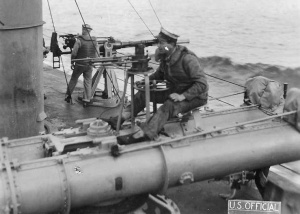Bliss-Leavitt Mk.1 (533 mm)
Contents
Description
The Bliss-Leavitt Mk.1 is a pre-WW1 torpedo developed by the United States for use against surface targets. Largely obsolete by the service dates of most US battleships present in War Thunder, it's only present on the earliest dreadnought hulls for use in underwater launchers.
Vehicles equipped with this weapon
General info
Tell us about the tactical and technical characteristics of the torpedo.
Effective damage
The Mk.1 only contains around 91 kg of TNT equivalent. Very little damage will likely be dealt upon detonation, with the most damage occurring to smaller vessels which can experience unrepairable breaches from the explosion. Capital ships are mostly immune, due to their thick belts. The best chance for damage to occur is if the torpedo hits an unprotected magazine or engine room on a ship with little standoff distance, such as a destroyer.
Comparison with analogues
Most torpedoes you come into contact with on the seas of War Thunder will be stronger, faster, and have a longer range. Torpedoes of a similar era, such as those found on the SMS Helgoland and HMS Dreadnought, run at similar speeds but contain slightly more explosive and can operate at much further ranges. The Mk. 1 does out-range early Russian dreadnought-launched torpedoes, but suffers in terms of speed.
Usage in battles
The rather limited range of this torpedo combined with its small payload makes it largely unsuitable for capital ship combat in War Thunder. The fixed underwater launchers found on early dreadnought hulls mean that the user's hull has to be almost perpendicular to the enemy to get a firing solution. Should you find yourself within a couple kilometres of an enemy ship, you may want to wait for the enemy's course to intersect with the firing angle of your launcher, rather than turn the entire hull and expose your broadside just to fire your torpedo. Only one can be loaded on each side of the ship at a time, and it takes time to reload.
If you are able to obtain an acceptable firing angle on an enemy ship, they may be surprised to find that you've fired a torpedo at all. Many early battleship captains opt not to carry them to reduce their explosion risk, and the underwater launchers don't create a visible plume of steam when fired, allowing them to be deployed with relative stealth.
Pros and cons
Pros:
- Can cause lethal flooding against smaller targets
- Large enough to reach unprotected magazines
Cons:
- Very slow
- Warhead is smaller than its contemporaries
- Requires very close range to use
History
Developed in 1904, the name Bliss-Leavitt combines the last name of its inventor, Frank McDowell Leavitt, with that of his employer, the E. W. Bliss Co. The Mk.1 was propelled by a single-stage vertical turbine engine, and powered by an alcohol-fired dry heater tied to a 2,250 psi air flask. The original development models of the torpedo ran cold - that is they fed compressed air into the engine without the use of any heating mechanisms. Once the torpedo went into production, however, a "combustion pot" or "superheater" was added between the air flask and engine. By heating the air prior to its introduction to the engine's combustion chamber, higher efficiency was achieved. This allowed the production version to sustain travel at 27 knots (50 km/h) for 4,000 yards (3,660 m), far surpassing the range of the preceding Whitehead torpedoes.
However, the Mk.1 variants suffered from stability issues due to its vertical compression turbine being tied to a single four-bladed propeller. The torque of the engine would often cause the torpedo to roll off course, an issue which was corrected in subsequent versions of the Bliss-Leavitt which used a two-stage engine with contra-rotating propellers.
As was often the case with torpedoes around this time, the Bliss-Leavitt Mk.1 carried wet gun cotton (nitrocellulose) and a percussion detonator, opting for a payload of 200 lbs (90 kg).
Media
Excellent additions to the article would be video guides, screenshots from the game, and photos.
See also
External links
- OP353W - A Brief History of U.S. Navy Torpedo Development (1978)
- http://www.navweaps.com/Weapons/WTUS_PreWWII.php#Bliss-Leavitt_21%22_%2853.3_cm%29_Mark_1
- https://maritime.org/doc/jolie/part1.php#page022




